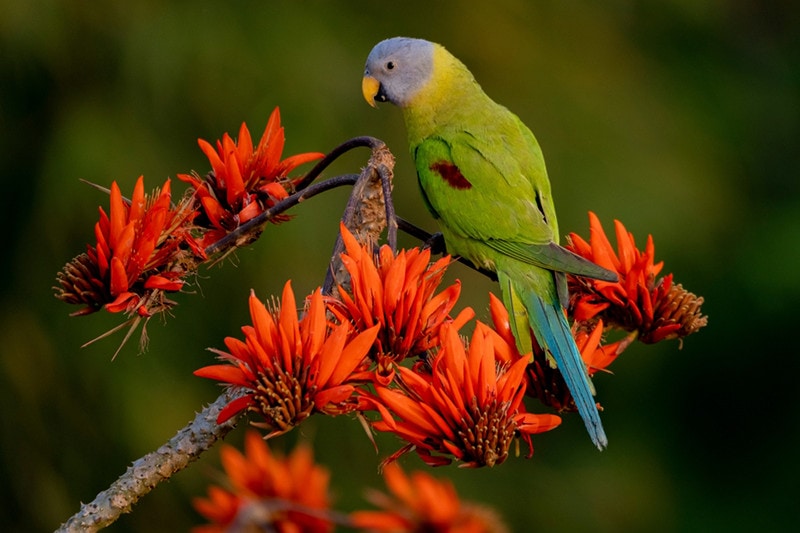
The pretty and colorful Blossom-Headed Parakeet is truly a sight to behold. These small parrots are beautifully contrasted and boast a confident personality when socialized, but they’re unfortunately threatened by poaching in the wild.
The plucky Blossom-Headed Parakeet is an interesting and fairly easy-to-keep bird, making it popular with novice owners who want an exotic-looking parrot. Read on to find out why they’re so popular among parrot enthusiasts everywhere.
Species Overview
Color:
Rose-pink, purple, blue, yellow, dark green, light green, orange
Size:
11.7 inches
Weight:
2.9 –3.1 ounces
Wingspan:
Moderate
Often confused with the similar (but distinct) Plum-Headed Parakeet, Blossom-Headed Parakeets are sociable and bright. They’re not overly noisy, but they like making their melodic voices heard. Like other parrots, they can mimic the sounds of other animals (and even people) if trained, and they do well with others of the same species. They’re also stunningly beautiful, which makes them incredibly popular as pets.
Blossom-Headed Parakeet Characteristics
History & Natural Habitat
The Blossom-Headed Parakeet has been kept as a captive pet for a very long time, probably because of how visually appealing they are! Vast numbers of these parrots were captured from their native habitat and imported into Europe, eventually being spread around the globe as pets.
The Blossom-Headed Parakeet is naturally found in Bhutan, North-East India, West Bengal, Thailand, Cambodia, Vietnam, and South-East China. These birds can be spotted in areas of light forests and forest edging mostly, but they can also be seen in savannahs and even on cultivated land.
Image Credit: Tareq Uddin Ahmed, Shutterstock
Things to Know When Owning a Blossom-Headed Parakeet
Temperament
Like many smaller parrots, the Blossom-Headed Parakeet is a sociable bird that thrives on the attention of their owners. With a curious and affectionate temperament (if provided enough stimulation), the Blossom-Headed Parakeet is a perfect parrot for owners wanting to create a strong and fruitful bond.
They’re also intelligent and love to learn new words and new tricks! However, the Blossom-Headed Parakeet needs company to be confident, so keeping a bonded pair together is best.
Sounds, Speech & Vocalizations
The Blossom-Headed Parakeet makes melodic and beautiful sounds that are not as intense as other, similar breeds. While they’re not as linguistically talented as other popular parrots (like the Alexandrine Parakeet), they can often mimic household sounds, bird songs, and even human speech.
However, like all parrots, the Blosson-Headed Parakeet can make repetitive or shrill calls. Be mindful of that if you live in an apartment!
Image Credit: Jyotirmoy Golder, Shutterstock
Blossom-Headed Parakeet Appearance
The bright and beautiful colors of the Blossom-Headed Parakeet are the reason the bird is so popular. Gorgeous pastel pinks and purples on the male’s head bleed into the greens and yellows of the body that are shared by both sexes.
Female Blossom-Headed Parakeets don’t share the brightness or variance in color that the males do but sport drab grey-blue heads and muted colors. Juvenile Blossom-Headed Parakeets have green heads that become colored as they age.
Caring for the Blossom-Headed Parakeet
The Blossom-Headed Parakeet shares many aspects of their care with other common parakeet species, such as the Plum-Headed Parakeet and the Alexandria Parakeet. They are social and should be housed with another Plum-Headed Parakeet to promote confidence and help alleviate boredom.
Because they’re intelligent, spending time with your Parakeet is essential. Boredom and loneliness can cause self-harm in parrots, including feather plucking and other repetitive behavior. With a bonded friend, your Blossom-Headed Parakeet should be kept engaged and confident enough to show off their natural inquisitiveness.
They have the same nutritional and exercise needs as other Parakeets since many of them originated from the same geographical area. When the Blossom-Headed Parakeet is bonded with their owner and comfortable with being handled, a supervised indoor flight can be a great source of enrichment!
Diet & Nutrition
Blossom-Headed Parakeets have similar nutritional needs as other small parrots, which makes it easier for them to find nutritionally balanced food. Basing your Blossom-Headed Parakeet’s diet on what they’d eat in their natural habitat is the best way to provide both nutrition and variety, but you should always ensure the correct vitamin and mineral levels are met.
It’s vital to provide fresh water for your Parakeet, which should be available at all times. Commercial Parakeet pellets are balanced to provide the correct levels of proteins, fats, vitamins, and minerals, and they should make up the bulk of your Blossom-Headed Parakeet’s daily diet.
Brands, such as the Roundybush Daily Maintenance Crumble Bird Food, prevent selective feeding and are recommended over seed mixes (which can lead to nutritional deficiencies).
Small portions of fruits and vegetables can also be provided for enrichment and added nutrition, plus they’re tasty!
Examples of healthy fruits and veggies include:
Papaya
Melon
Mango
Banana
Pumpkin
Carrot
Cucumber
Swiss Chard
They can also be given treats (occasionally), such as sprays of millet. Too many seeds or treats can cause nutritional imbalance or health problems, such as high cholesterol, high blood pressure, and obesity.
Cage & Housing Requirements
Your Blossom-Headed Parakeet’s cage is one of the most important choices you’ll make when considering homing one. As they’ll spend a lot of time in their cage, it needs to be more than spacious enough to provide space to hop, fly, and for toys and bowls.
The best enclosures for Blossom-Headed Parakeets are walk-in aviaries since they provide the room they need to fly. The minimum length of an aviary for a Blossom-Headed Parakeet is 9.8 feet, and they can even be kept in outdoor aviaries in warmer climates. If you choose to keep your Parakeet outside, ensure they have a secure roosting box and plenty of shelter from the elements.
Remember that more than one Parakeet will require more space, so consider that before deciding on how many you’d like to adopt. Cage bars should also be kept to a maximum of half an inch apart; Blossom-Headed Parakeets are inquisitive and could easily get their beaks stuck!
If using an aviary isn’t feasible in your home, you can get a cage that measures 18” L x 18” W X 24” H, but that’s only the minimum. Parakeets and other small birds are happiest in large cages.
Toys and perches (and the space for them) are also important for the enrichment of your Blossom-Headed Parakeet. Adding mirrors, bells, rings, and chew toys can help alleviate boredom and exercise your bird’s natural curiosity.
Image Credit:Karel Bartik, Shutterstock
Exercise
Exercise is important for Blossom-Headed Parakeets since they can become overweight and develop other health problems if they’re not moving enough. Lack of exercise can also cause psychological problems, and they need stimulation to thrive. Different sizes and levels of perches can promote flight within the cage, and perches made from different materials with different thicknesses can keep your Parakeet’s feet strong and healthy.
While any time outside of the cage always comes with a few risks, your Blossom-Headed Parakeet must get this valuable exercise opportunity. Handling your Parakeet can help acclimate them to the world outside of their cage, and allowing them time to roam freely in the room each day can keep them fit and happy.
It’s important to ensure any free-roaming space is completely secure before allowing your Blossom-Headed Parakeet out for exercise, including securing any windows or doors, ensuring they’re closed, and blocking off places where they may get stuck.
Health & Conditions
While Blossom-Headed Parakeets are generally healthy birds, there are some illnesses and conditions that they are more likely to experience. Some of these are caused by poor care or diet (such as nutrient deficiencies or mites), while others can be environmental or genetic predispositions.
It’s important to register your Blossom-Headed Parakeet with an exotics veterinarian experienced with parrots since birds can get sick very quickly and not every veterinary surgery can effectively treat them.
Minor Conditions
Egg binding
Feather Plucking
Skin infections
Serious Conditions
Psittacosis
Candidiasis
Hepatic Lipidosis
Cancer
3 Little-Known Facts About the Blossom-Headed Parakeet
1. Blossom-Headed Parakeets Can Live for Up to 20 Years!
2. The Average Clutch Size of A Blossom-Headed Parakeet Is Four to Five Eggs
3. Blossom-Headed Parakeets Are “Near Threatened” on the IUCN Red List
Image Credit: Paulose NK, Shutterstock
Conclusion
Blossom-Headed Parakeets are bright, intelligent, and personable parrots that can bring a lot of colorful joy to their owners. These birds are medium-sized but big in personality, and they still need plenty of room to fly around and play!
You’ll find a wonderful companion in the Blossom-Headed Parakeet; they enjoy socializing with their owners and have even been known to cuddle with them. Plus, these pretty Parakeets will likely get along well with other species living with them in their aviary.
Featured Image Credit: iqbal.sohag, Shutterstock






